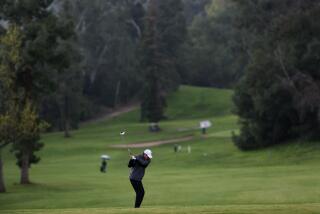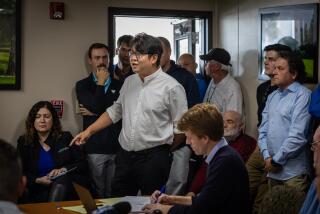Golfers Told to Stymie Skin Cancer With Sun Protection
- Share via
WASHINGTON — Dr. Patti Farris knows a golfer when she sees one. The hands are the giveaway.
On a golfer, one hand often has more skin cancer or precancerous patches than the other, Farris said. The other hand is protected from the sun by a glove.
“That’s something any practicing dermatologist in the South would have observed,” said Farris, a dermatologist in New Orleans and an amateur golfer.
She and other members of the American Academy of Dermatology warn that golf gives people a higher risk of skin cancer.
“Anyone who is an outdoors enthusiast has a higher risk,” Farris said. But because the risk rises with hours spent in the sun, as well as with the intensity of the sunlight, golfers have an outsized risk, she said.
“The interesting thing about golf is that golf takes 4 1/2 hours to play,” Farris said. And the chances are good that golfers will be on the course during the most intense hours of sunlight, before and after noon. “Even if you tee off at 8 o’clock, you are still out there after noon.”
A new survey underscores the risk. The poll for Golf for Women magazine looked at 1,010 responses to 1,800 questionnaires mailed to female golfers. About 1 in 50 respondents said they have had skin cancer. Men probably have a similar risk, Farris said.
As a result, dermatologists, sunscreen companies and the Ladies Professional Golf Assn. are working together on skin cancer detection and prevention. Dermatologists and representatives of the Ombrelle sunscreen company will visit 10 LPGA Tour sites. The program will give pros and spectators skin cancer screenings, product samples and advice.
Golfers ought to wear protective clothing, including long pants, long-sleeve shirts, and hats or visors with broad brims, Farris said. They also should wear a sunscreen with an SPF of at least 15, and the sunscreen should protect against both ultraviolet A and B light, she said.
UVA poses a higher risk of the more common but slower-growing basal and squamous cell cancers, which are easier to treat and thus less likely to cause death. UVB carriesa higher likelihood of leading to the less common but faster-growing and more deadly form of skin cancer, melanoma.
Pro shops also are being asked to promote sun safety, said Dr. Roger Ceilley, the academy’s immediate past president and a dermatologist in Des Moines, Iowa. And doctors themselves--often not strangers to golf--are being targeted as well, he said.
“I try as much as I can,” Farris said. “I play a lot during the evening after work during Daylight Savings Time.” Besides waiting for a time when the sunlight is less intense, she wears a broad-brimmed visor, a long-sleeve shirt when the heat isn’t too intense, and a broad-spectrum sunscreen.
“I have never had a sunburn on the golf course yet,” Farris said.
Touring pros take the risk seriously, said pro Cindy Rarick of Tucson, Ariz. Many are prematurely wrinkled or have dry skin, she said: ‘You can see a lot of the older players have sun-damaged skin. Whether they have skin cancer is a different story.”
The older players didn’t have the products or knowledge available today, Rarick said. Players now wear visors or baseball caps, sunscreens and--unless hot weather makes it too difficult--pants and long-sleeve shirts, she said.
More to Read
Sign up for Essential California
The most important California stories and recommendations in your inbox every morning.
You may occasionally receive promotional content from the Los Angeles Times.













